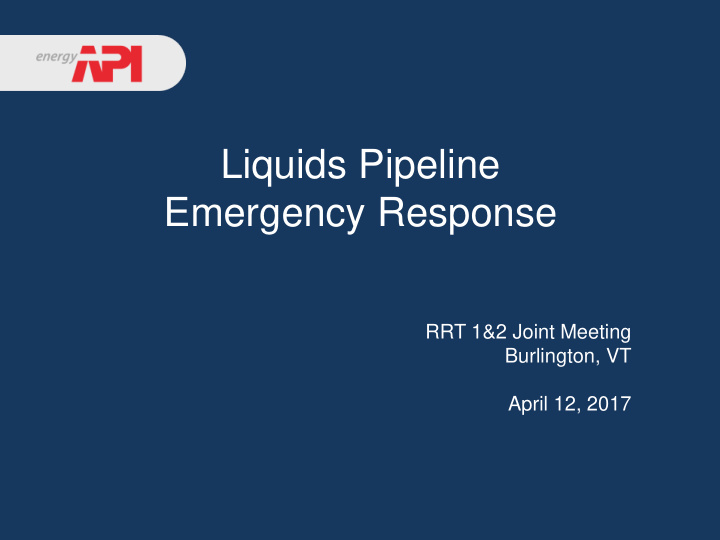



Liquids Pipeline Emergency Response RRT 1&2 Joint Meeting Burlington, VT April 12, 2017
Overview • Industry Preparedness • Supply Chain and M arkets • Infrastructure – Pipelines – M arine – Rail/ Truck • Vulnerabilities • Engagement and Waivers • Industry Focus – Security Issues – Safety and Integrity M anagement – Safety M anagement System – Public Awareness – First Responder Engagement – Spill Impact M itigation Assessment (SIM A) • Questions/ Discussion
Industry Preparedness • API Recommended Practice (RP) 1174 – Onshore Hazardous Liquid Pipeline Emergency Preparedness and Response (December 2015) – Emergency M anagement System – M anagement of Change – Planning – Training and Exercises – Response (ICS) – M easuring and Continual Improvement
Industry Preparedness • http:/ / www.api.org/ ~/ media/ Files/ Policy/ Safety/ ONG-Industry-Preparedness- Handbook-v2.pdf
Industry Preparedness • Oil and Natural Gas Industry Preparedness Handbook – Response Strategy – Energy Supply Chains – National Response Coordination – Preparing at the State and Local Levels – Potential Waivers – Distribution and Ownership of Retail Stations
Industry Preparedness • Educating Stakeholder Groups – Utilize and disseminate materials to educate stakeholder groups – Hold regular educational sessions with decision makers and stakeholder groups to explain oil and gas systems, markets, and critical functions – Utilize existing relationships and mechanisms to ensure channels of communication are open and effective – Identify key staffing changes within stakeholder groups that warrant and education of the complexities of the O&G systems.
Industry Preparedness • Formalizing Processes of Communication and Information Sharing – Work with local and state-based industry organizations to identify industry roles and responsibilities surrounding communication – Facilitate effective communication between key govt representatives and company/ facility reps – Develop processes to facilitate information sharing between impacted facilities and govts – Utilize existing exercises and drills to understand and institutionalize the processes and procedures once they are recognized and accepted
Supply Chain
Supply Chain
Supply Chain
Markets
Infrastructure • https:/ / www.eia.gov/ analysis/ transportationfuels/ padd1n3/
Infrastructure
Infrastructure • Issues/Update
Infrastructure
Infrastructure
Infrastructure
Infrastructure
Infrastructure
Infrastructure
Vulnerabilities • Positives – Highly flexible; many supply sources (Colonial Pipeline, refineries, imports) – NY harbor has approx. 70 million barrel storage capacity (manage disruptions) – DOE NE Gasoline Supply Reserve – 700,000 barrels in NY harbor area. • Negatives – Highly interconnected pipeline system; infrastructure damage could result in cascading effect (as we saw in Sandy with Colonial Pipeline fully backed up to NC) – No DOE emergency reserve of heating oil (18% of homes in sub-P ADD region)
Infrastructure
Infrastructure
Infrastructure
Infrastructure
Infrastructure
Vulnerabilities • Pros – DOE emergency reserves of gasoline and heating oil in sub- P ADD 1a – Can offset disruptions in supply domestically by increasing imports from Canada • Cons – Almost all coming in via marine shipment; a disruption to area ports can have large impacts, especially in winter months – Heavy reliance on distillates for home heating (39% in 2013; over 50% of distillate consumption in region) – Jones Act sensitivities during emergency situations that heavily impact supply centers
Engagement and Waivers
Engagement and Waivers
Industry Focus Areas
Focus: Pipeline Security
Focus: Integrity Management • API RP 1176 – Assessment and M anagement of Cracking in Pipelines • API RP 1160 – M anaging System Integrity for Hazardous Liquid Pipelines • API Technical Report 1178 – Data M anagement and Integration Guideline • API Technical Report 1179 – Guidelines for Use of Hydrostatic T esting as an Integrity M anagement T ool
Focus: Safety • 99.999% by volume safety rate of pipelines (FERC and PHM SA data) • Crude by rail has a 99.99% by volume safety rate (American Association of Railroads) • Shipment of crude by rail has decreased by 60% to P ADD 1 (58,653 mbbl in 2016 vs. 143,973 mbbl in 2014; EIA Data)
Focus: Safety
Focus: Safety Management System • API RP 1173 – Pipeline Safety M anagement S ystems – Leadership Commitment – Stakeholder Engagement – Risk M anagement – Operational Controls – Incident Investigations and Learnings – Safety Assurance – M anagement Review and Continual Improvement – Emergency Preparedness and Response (RP 1174) – Competence and Training – Documentation and Recordkeeping – Safety Culture
Focus: Public Awareness • API Recommended Practice 1162 – Public Awareness Programs for Pipeline Operators • Inland Educational Leaflets • First Responder Engagement
Focus: First Responder Engagement • Emergency Responder Forum – Biannual meeting • Conferences: – API Pipeline Conference – International Oil Spill Conference – International Association of Fire Chiefs (IAFC) – National Association of State Fire M arshals (NASFM ) – National Volunteer Fire Council (NVFC) – Clean Waterways
Spill Impact Mitigation Assessment • Spill Impact M itigation Assessment (SIM A) is currently in draft form and in Industry will replace Net Environmental Benefit Analysis (NEBA) • Will be published under API, IPIECA, and IOGP logos • Expected finalization by late summer
Questions/Discussion Colin M . Frazier Policy Advisor – M idstream and Industry Operations American Petroleum Institute 1220 L Street, NW | Washington, DC 20005 Office (202) 682-8186 FrazierC@api.org
Recommend
More recommend